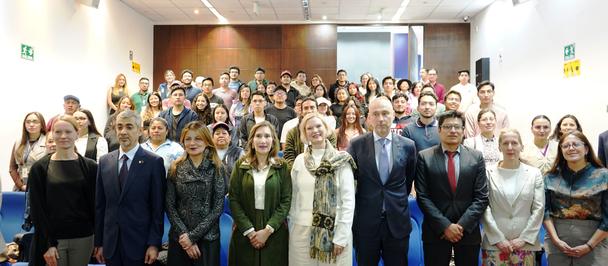Learning from successful digital marketers to fight hate and false narratives online
June 27, 2022

Photo by Kojo Kwarteng
By Lillian Njoro, Head of Experimentation, UNDP Accelerator Lab
In 2020 at the onset of the COVID-19 pandemic, the world saw the rise of the infodemic, bringing to sharp focus the challenge of information pollution which we continue to grapple with in a world that is more interconnected than ever. In recent years, we have seen many innovative interventions targeting online misinformation and disinformation which leverage various technology approaches. However, the common pitfall that seems to befall these interventions is the speed with which mis- and disinformation spreads online. “A lie can travel halfway around the world while the truth is putting on its shoes” is a well-known quote that has never been truer than in the world we live in today. In today’s world, for interventions addressing online mis- and disinformation, the challenge has become how to get as much engagement to counter the spread of harmful content. This is where thinking like a digital marketer comes in, which involves the use of the internet and digital technologies like mobile phones to access consumers online and promote products and services.
Partnership with Google Ads Grant
In 2021, Google committed US$ 20 million in free advertising to select UN agencies to help drive global recovery from the pandemic through their Ad Grants Crisis Relief Fund. By partnering with Google Ads, Google’s in-house advertising platform, UNDP launched online campaigns to disseminate key messages directly to people looking for information through Google searches to test the application of digital marketing approaches for amplifying relevant development initiatives to the public. Kenya was one of the countries selected to pilot this initiative, and the Accelerator Lab worked closely with the ‘Transcending Foundations of Peace and Security for Inclusive and Sustainable Development Programme’ on the ‘Fighting hate and false narratives’ campaign, which ran from the end of 2021 to early 2022. The objectives of the campaign were twofold:
- Increasing and amplifying platforms for inclusive public engagement and development discourse among the youth through leveraging gamification for interactive youth engagement in partnership with Usiku Games
- Increasing public capacity to verify the information and amplify the influence of credible information sources through leveraging digital tools like chatbots in partnership with PesaCheck
We experimented with various digital marketing approaches and ran online campaigns for several weeks using the Google Ads Grant facility to try and achieve our intended objectives.
Our results and learnings
We ran two campaigns, the first in partnership with PesaCheck, to promote their WhatsApp fact-check tip line, and the second in partnership with Usiku Games to promote their civic democracy game, Wewe.Vote, using Google Search adverts. The target audience for the campaigns was primarily youth aged 18 to 34, based in urban areas in Kenya. The keywords used in the two campaigns included words like ‘coronavirus’, ‘vaccine’ and ‘WhatsApp’ for the tip line and variations of ‘free online game’ for the gaming platform.
The key metrics that we were tracking were:
- Impressions – the number of times an advert was displayed
- Clicks – the number of clicks on the advert (that is, the user engagement with the advert)
- Click-through rate (CTR) – the number of clicks the ad receives versus the number of times the ad is seen (that is, clicks ÷ impressions)
- Cost-per-click (CPC) – the amount of money required to produce a single click on an ad (total cost ÷ total number of clicks)
Figure 1: Performance metrics of the Factcheck tip line campaign
Figure 2: Performance metrics of the civic democracy game campaign
For both campaigns, a clear spike was evidenced at the start which gradually tapered out with time. The tapered performance of the tip line could be linked to a drop in search interest over time for words like Coronavirus, COVID-19 and vaccine as per Google’s analysis of popular search terms and trends. The performance of the search ad campaigns is heavily reliant on the use of strategic keywords to ensure that they remain relevant and responsive to the shifting interests of the intended audience.
Figure 3: Graph of search interests over time from Google trends data
Additionally, we reviewed the performance of the campaigns across various user segments and demographics. Overall, the campaigns performed best with the male demographic and received the highest amount of engagement within the 18 to 24 age brackets. This can be attributed to the high numbers of young people in Kenya who are active internet users as opposed to the older age groups. Demographic data from Meta’s ad audience indicates that despite Kenya having a higher percentage of women, there are more male internet users across all the age demographics.
Figure 4: Graph of campaign performance against gender
Figure 5: Graph of campaign performance against age group brackets
The data also showed that most of the users accessed the game and tip line via computer and mobile device respectively.
Figure 6: Graph of campaign performance against device type
Way forward
Overall, the campaigns succeeded in increasing the engagement of the promoted content (tip line and game) with the youth demographic evidenced by the number of clicks and impressions from the campaigns. Based on the insights gathered from this first phase, we have developed further areas of exploration and experimentation that we are looking into for the next phase which include:
- Integration of measurement of conversions, that is, tracking the percentage of users who complete the intended goals of the landing page to get a better sense of the ‘real-world’ impact of the digital campaigns
- Optimizing the content on the landing pages to enhance user experience, bearing in mind the demographic profiles of the target audience for the campaigns
- Experimenting with various keywords to optimize the search ads for maximized impressions
- Exploring the integration of display ads which allow for the addition of visual elements, such as photos and videos, to attract a wider audience
As part of the global pilot initiative with Google Ads, some of the insights from this experiment have been used in the development of a policy brief and guidance note developed by the Global Policy Network titled ‘From Pilots Towards Policies: Utilizing Online Data for Preventing Violent Extremism and Addressing Hate Speech’. We look forward to harnessing these insights in the implementation of peacebuilding initiatives with partners, before, during and after the General Elections in Kenya.
The views expressed in this post are those of the author and in no way reflect those of UNDP.

 Locations
Locations


